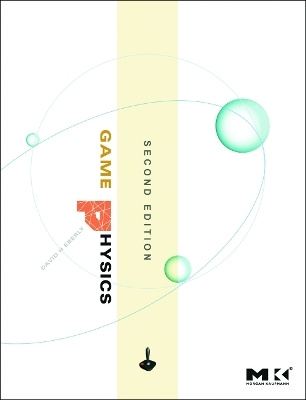
Game Physics
Focal Press US (Verlag)
978-0-12-374903-1 (ISBN)
Create physically realistic 3D Graphics environments with this introduction to the ideas and techniques behind the process. Author David H. Eberly includes simulations to introduce the key problems involved and then gradually reveals the mathematical and physical concepts needed to solve them. He then describes all the algorithmic foundations and uses code examples and working source code to show how they are implemented, culminating in a large collection of physical simulations. The book tackles the complex, challenging issues that other books avoid, including Lagrangian dynamics, rigid body dynamics, impulse methods, resting contact, linear complementarity problems, deformable bodies, mass-spring systems, friction, numerical solution of differential equations, numerical stability and its relationship to physical stability, and Verlet integration methods. This book even describes when real physics isn't necessary - and hacked physics will do.
Dave Eberly is the president of Geometric Tools, Inc. (www.geometrictools.com), a company that specializes in software development for computer graphics, image analysis, and numerical methods. Previously, he was the director of engineering at Numerical Design Ltd. (NDL), the company responsible for the real-time 3D game engine, NetImmerse. He also worked for NDL on Gamebryo, which was the next-generation engine after NetImmerse. His background includes a BA degree in mathematics from Bloomsburg University, MS and PhD degrees in mathematics from the University of Colorado at Boulder, and MS and PhD degrees in computer science from the University of North Carolina at ChapelHill. He is the author of 3D Game Engine Design, 2nd Edition (2006), 3D Game Engine Architecture (2005), Game Physics (2004), and coauthor with Philip Schneider of Geometric Tools for Computer Graphics (2003), all published by Morgan Kaufmann. As a mathematician, Dave did research in the mathematics of combustion, signal and image processing, and length-biased distributions in statistics. He was an associate professor at the University of Texas at San Antonio with an adjunct appointment in radiology at the U.T. Health Science Center at San Antonio. In 1991, he gave up his tenured position to re-train in computer science at the University of North Carolina. After graduating in 1994, he remained for one year as a research associate professor in computer science with a joint appointment in the Department of Neurosurgery, working in medical image analysis. His next stop was the SAS Institute, working for a year on SAS/Insight, a statistical graphics package. Finally, deciding that computer graphics and geometry were his real calling, Dave went to work for NDL (which is now Emergent Game Technologies), then to Magic Software, Inc., which later became Geometric Tools, Inc. Dave's participation in the newsgroup comp.graphics.algorit
Game Physics
1st edition
1 A Brief History of the World: A Summary of the Topics
2 Basic Concepts
3 Rigid Body Motion
4 Deformable Bodies
5 Physics Engines
6 Physics and Shader Programs
7 Linear Complementarity and Mathematical Programming
8 Differential Equations
9 Numerical Methods
10 Quaternions
Appendices
A Linear Algebra
B Affine Algebra
C Calculus
D Ordinary Difference Equations
A Summary of the Changes for the 2nd Edition:
Naturally, Chapter 1 (Introduction) will be rewritten based on the contents for the second edition.
The chapter on Physics Engines needs a significant rewrite. The goal will be to describe how to implement a classic rigid-body physics engine. And there will be source code to go with it, illustrating a generic collision detection system to go with the collision response people seem to associate with a physics engine. I will also include a new section on ragdoll physics, and there will be source code to go with this.
I plan on inserting a new chapter (chapter 6 below) that will contain descriptions of various papers of interest in game physics. In particular, I will review publications by Ronald Fedkiw, Jos Stam, and James O'Brien, choosing a few of each to describe and to implement in source code and include on the CDROM for the book. This new material fills the void in the 1st edition - not much discussion of applications of particle systems, fluids, or gases. The chapter on shader programs (old Chapter 6) will be discarded in its entirety.
Chapters 7 through 10 and Appendices A through D form the mathematical heart of the book. The appendices are effectively background material that a reader will be exposed to at a university. The chapters 7 through 10 are more advanced topics. I believe it is reasonable to break the book into two parts:
Part I -The Physics
1 Introduction
2 Basic Concepts
3 Rigid Bodies
4 Deformable Bodies
5 Physics Engines [rigid body concepts]
6 Particles, Fluids, and Gases [deformable body concepts]
Part II -The Mathematics
7 Linear Algebra
8 Affine Algebra
9 Calculus
10 Quaternions
11 Differential Equations
12 Difference Equations
13 Numerical Methods
14 Linear Complementarity and Mathematical Programming
The idea is that Part I is readable immediately by anyone having a reasonable mathematics background. Portions of Part II can be read, as needed.
The chapter on Linear Complementarity will be rewritten to omit the Lemke algorithm, replacing it by a discussion of iterative methods to solve LCP.
The 2nd edition will contain a lot more source code. And, as mentioned previously, we should include CD-ROM icons in the margins to let readers know that there is source code to illustrate the concepts.
| Verlagsort | Burlington |
|---|---|
| Sprache | englisch |
| Maße | 191 x 235 mm |
| Gewicht | 1940 g |
| Themenwelt | Informatik ► Software Entwicklung ► Spieleprogrammierung |
| ISBN-10 | 0-12-374903-4 / 0123749034 |
| ISBN-13 | 978-0-12-374903-1 / 9780123749031 |
| Zustand | Neuware |
| Haben Sie eine Frage zum Produkt? |
aus dem Bereich


